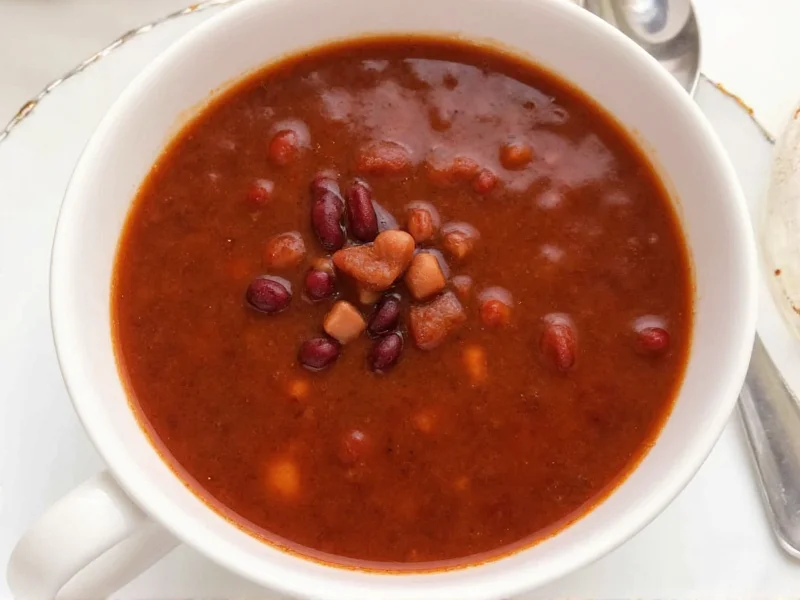Red bean soup has been a cherished dessert across East Asian cultures for centuries, particularly in China, Japan, and Korea. This simple yet deeply satisfying dish showcases how minimal ingredients can create complex flavors through careful preparation. Unlike Western desserts that often rely on heavy creams and artificial additives, authentic red bean soup derives its sweetness naturally from the beans themselves, with only modest sugar enhancement.
The Cultural Significance of Red Bean Soup
Originating in ancient China, red bean soup spread throughout Asia, adapting to local tastes while maintaining its core identity. In Chinese tradition, the soup symbolizes good fortune and is commonly served during festivals and family gatherings. Japanese versions often feature a smoother texture and may include mochi, while Korean patjuk typically incorporates rice and is eaten during the winter solstice.
Essential Ingredients for Authentic Red Bean Soup
The magic of red bean soup lies in its simplicity. You only need a few quality ingredients to create an authentic experience:
| Ingredient | Quantity | Notes |
|---|---|---|
| Dried adzuki beans | 1 cup (200g) | Rinse thoroughly before use |
| Water | 4 cups (950ml) | Plus additional for soaking |
| Sugar | 1/3 cup (75g) | Adjust to taste; rock sugar preferred |
| Lotus seeds (optional) | 2 tablespoons | Adds texture and traditional flavor |
| Glutinous rice balls (optional) | 1/2 cup | For added texture and authenticity |
Step-by-Step Preparation Guide
Creating perfect red bean soup requires attention to detail at each stage. Follow these steps for authentic results:
Preparation
Sort through your dried adzuki beans to remove any stones or damaged beans. Rinse them thoroughly under cold water until the water runs clear. Soak the beans in enough water to cover them by 2 inches for 2-4 hours. While traditional methods recommend overnight soaking, adzuki beans require less time than other legumes due to their smaller size.
Cooking Process
- Drain and rinse the soaked beans
- Place beans in a pot with 4 cups fresh water
- Bring to a boil over medium-high heat
- Reduce heat to low and simmer uncovered for 45-60 minutes
- Skim off any foam that forms on the surface during the first 15 minutes
- Add sugar when beans are tender but still hold their shape
- Continue simmering for 5-10 minutes after adding sugar
- Remove from heat and let rest for 15 minutes before serving
Perfecting Your Red Bean Soup Texture
The ideal red bean soup features tender beans suspended in a slightly thickened, naturally sweet broth. The beans should remain intact but yield easily when pressed against the roof of your mouth. For a creamier texture without losing the bean integrity, try mashing 1/4 of the cooked beans against the side of the pot with a wooden spoon before adding sugar.
Regional Variations to Explore
Once you've mastered the basic recipe, experiment with these authentic regional adaptations:
- Chinese style: Add lotus seeds and longan during the last 20 minutes of cooking for enhanced flavor complexity
- Japanese style: Use slightly less sugar and serve with small mochi balls for textural contrast
- Korean patjuk: Incorporate rice or rice cakes and serve during winter months for warmth
- Vegan adaptation: Substitute sugar with maple syrup or coconut sugar for a refined sugar-free version
- Cold preparation: Chill completely and serve as a refreshing summer dessert
Troubleshooting Common Issues
Even experienced cooks encounter challenges with red bean soup. Here's how to address frequent problems:
- Beans remain hard after cooking: Older beans require longer cooking times. Ensure you're using fresh adzuki beans and consider extending simmer time by 15-20 minutes.
- Soup too watery: Simmer uncovered for additional 10-15 minutes to reduce liquid, or mash some beans to naturally thicken the broth.
- Excessive foaming: Skim foam regularly during the first 15 minutes of cooking, which indicates proteins releasing from the beans.
- Overly sweet: Balance with a squeeze of lemon juice or additional unsweetened bean liquid.
Serving and Storage Recommendations
Red bean soup tastes best when served warm but can be enjoyed hot or cold depending on the season. For traditional presentation, serve in small ceramic bowls. The soup actually improves in flavor after resting for several hours as the flavors continue to meld.
Store leftovers in an airtight container in the refrigerator for up to 5 days. The soup will thicken upon cooling, so add a small amount of water when reheating. For longer storage, freeze portions for up to 3 months. Thaw overnight in the refrigerator before reheating gently on the stove.
Nutritional Benefits of Red Bean Soup
Adzuki beans provide impressive nutritional value beyond their delightful flavor. They're rich in dietary fiber, protein, and essential minerals including potassium, magnesium, and iron. Unlike many desserts, red bean soup offers sustained energy without the sugar crash, making it a more balanced sweet treat. The natural antioxidants in adzuki beans contribute to overall wellness while satisfying your sweet tooth.











 浙公网安备
33010002000092号
浙公网安备
33010002000092号 浙B2-20120091-4
浙B2-20120091-4